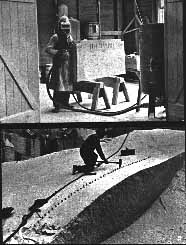

Closely tied to the industry's history is a strong cultural tradition as the granite industry was largely made up of immigrants from Italy, Scotland, Canada and Sweden. The Scots are thought to be the first immigrants to arrive from the granite region near Aberdeen for employment in Barre's granite industry from the mid to late 1800s. They were followed soon after in the late nineteenth century by Italian immigrants, who became well known for their carving skill and techniques. Later, in the late nineteenth and early twentieth centuries, workers from others countries, including Scandinavia, Greece, Ireland, England, Canada and Spain joined the ranks of the Barre granite workers. Each ethnic population had its own cultural community within Barre's North End, which had become the immigrant workers section of town. In 1880, when the granite industry was still small scale, 95% of the population of Barre was native-born. By 1910, when the industry was employing over three thousand people, that number had dropped to 62%. The Italian population was very active politically and unions had a strong voice in the conditions of the workers. There were fifteen local unions in 1900, comprised of more than 90% of Barre's working class.
The 1922 strike greatly affected the community and the Jones Brothers Company responded to grievances by building a recreation room for its employees in 1923 to provide hot meals from local restaurant for the workers. Two men per shift were responsible for overseeing the recreation room and this action showed the managementís efforts to work amiably with the workers. This recreation room was later transformed into the Sandblast Studio and eventually, after the granite works closed down, into an office space.